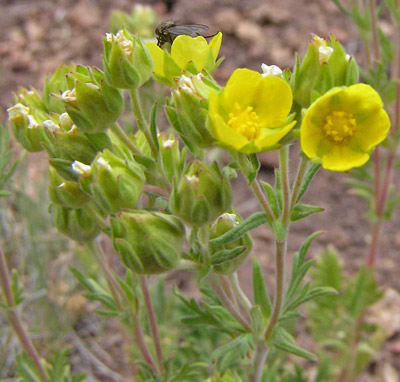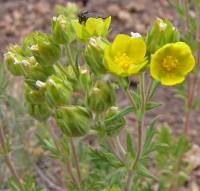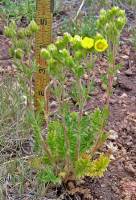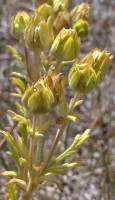Duration: Perennial
Nativity: Native
Lifeform: Forb/Herb
General: Perennial, 5-35 cm tall; stems few to several, clustered, erect to sometimes decumbent, loosely spreading-villous, grayish green; caudex branched, scaly; taproot thick.
Leaves: Mostly basal, some cauline, alternate, pinnately 5-11 foliate, leaflets oblanceolate in outline, 0.8-3 cm long, pinnatifid, cleft about halfway to the midvein, with more-or-less 10 lobes, green and usually strigose above, grayish tomentose beneath, ultimate margins rolled under; stipules with entire to irregularly cleft margins; basal blades long-petiolate, cauline blades short-petiolate.
Flowers: Inflorescence an open, branched, leafy cyme; flowers numerous, relatively inconspicuous; hypanthium shallowly cup-shaped, hirsute externally; bractlets broadly lanceolate, 3-7 mm long; sepals broadly lanceolate to deltate, 3.5-8.5 mm long; petals broadly obovoid, 2-4 mm long, yellow; stamens 15-20; pistils numerous, the style 0.7-0.8 mm long; flowers June-August.
Fruits: Achene, 1.1-1.4 mm long, yellowish green, slightly wrinkled to smooth.
Ecology: Montane slopes, rocky, exposed subalpine and alpine habitats; 2100-3700 m (7000-12000 ft); Apache and Coconino counties; Canada, northeastern, north-central, western, and southwestern U.S.
Notes: Potentilla plattensis (Platte River cinquefoil) is a perennial, 5-25 cm tall, stems usually several, decumbent to spreading; herbage is appressed-strigose; leaves are mostly basal, 11-23 foliate, leaflets 5-15 mm long, pinnately divided to the midvein into linear segments; cymes are widely spreading; pedicels are 1-4 cm long, curved-spreading, at least in fruit; petals are obovate, 3.5-7.5 mm long, yellow; stamens are 20; achenes are 1.3- 1.5 mm long, the style 1.5-2.2 mm long. It occurs in meadows, streambanks, and montane habitats at 2000-2600 m (6500-8500 ft). Potentilla arizonica (Arizona cinquefoil) is very similar to P. plattensis, but is distinguished primarily by its erect or ascending habit; herbage is densely long-villous; leaves are 15-25 foliate; and the pedicels are erect or ascending. Endemic to Arizona, it is scattered sporadically in meadows in ponderosa pine forests between Flagstaff and Williams. The Navajo use the root of P. pensylvanica as a life medicine (cure- all).
Editor: Springer et al. 2008
Perennial from a stout taproot and often a branched caudex, decumbent to erect, 2-8 dm, the stem thinly to densely tomentose; lvs pinnately compound, glabrous to sericeous above, subglabrous to white-tomentose beneath, the lower long-petioled, the cauline progressively reduced and less petioled or subsessile; lfls 5-13 (+), or 3 in smaller lvs, the upper 3 approximate and often confluent, oblanceolate to obovate, deeply toothed or cleft; stipules of the cauline lvs commonly laciniate; infl usually a compact cyme, seldom over 5 cm wide; pet yellow; style 1 mm, terminal, thickened and glandular at base; 2n=14, 28, 56. A polymorphic sp. of n. and w. N. Amer. and much of temperate and boreal Eurasia, often divided into a number of spp. or infraspecific taxa. Our plants can be sorted into 3 morphologically confluent but cytologically apparently distinctive vars.
Gleason, Henry A. & Cronquist, Arthur J. 1991. Manual of vascular plants of northeastern United States and adjacent Canada. lxxv + 910 pp.
©The New York Botanical Garden. All rights reserved. Used by permission.









